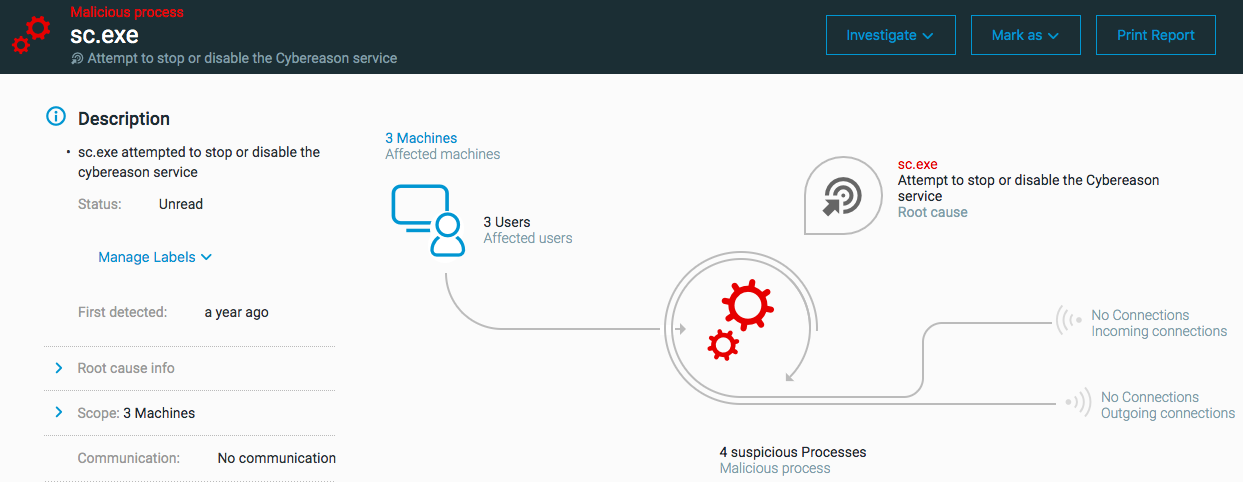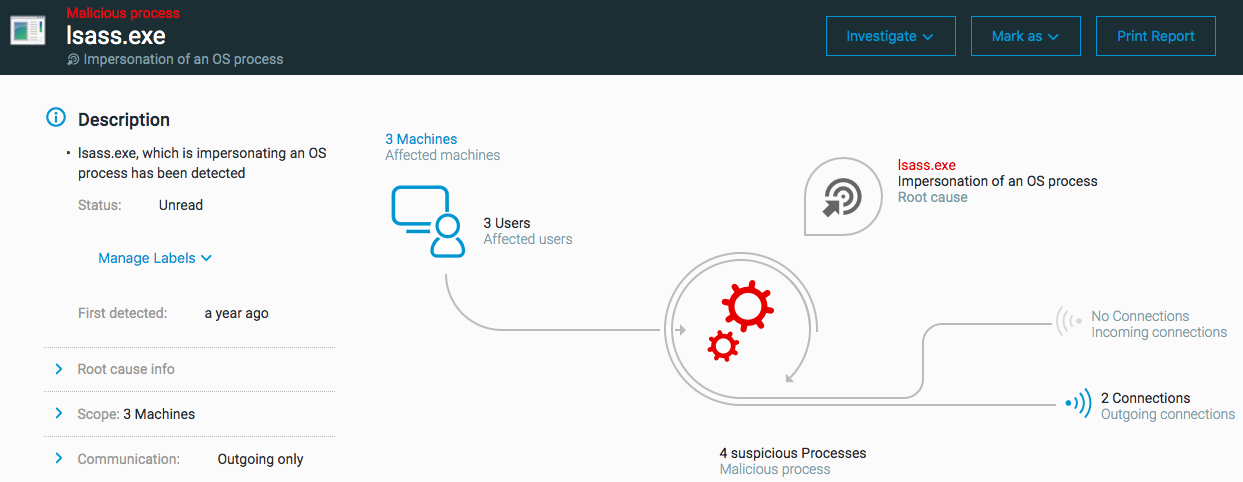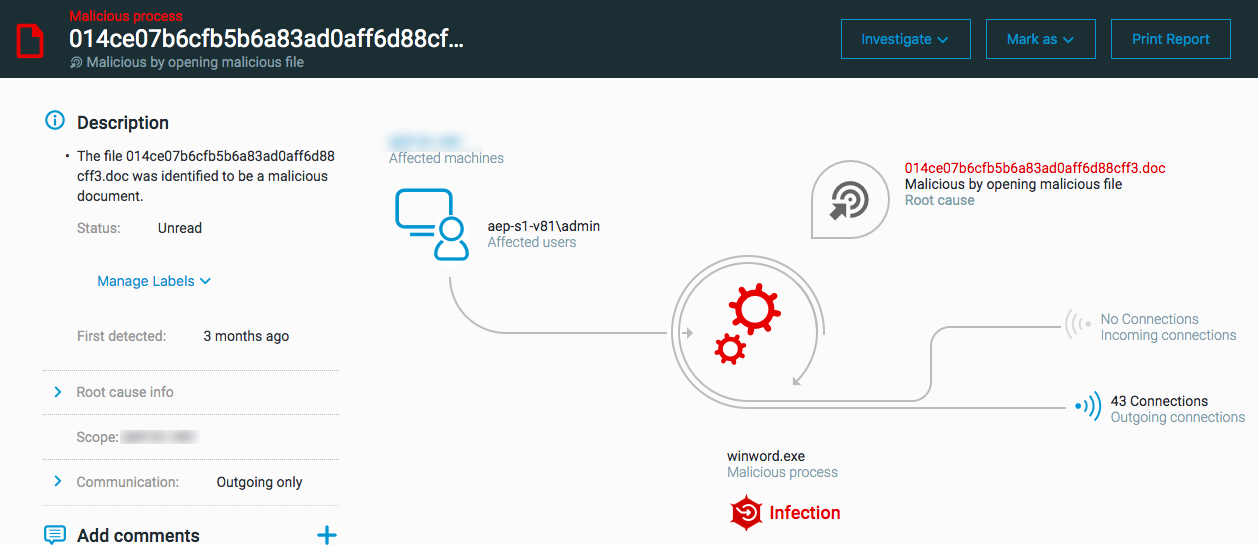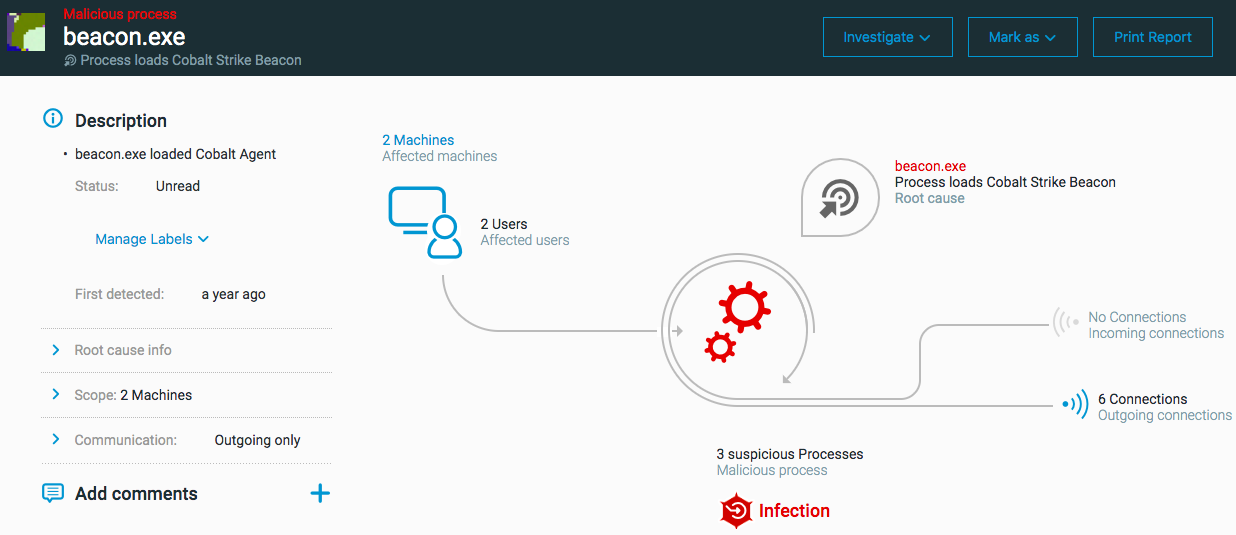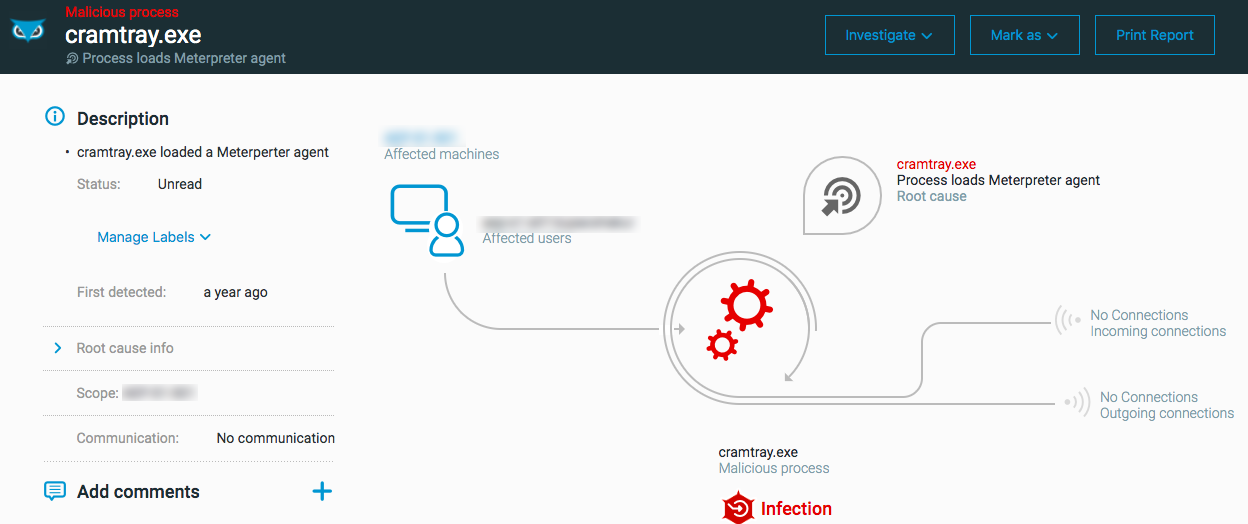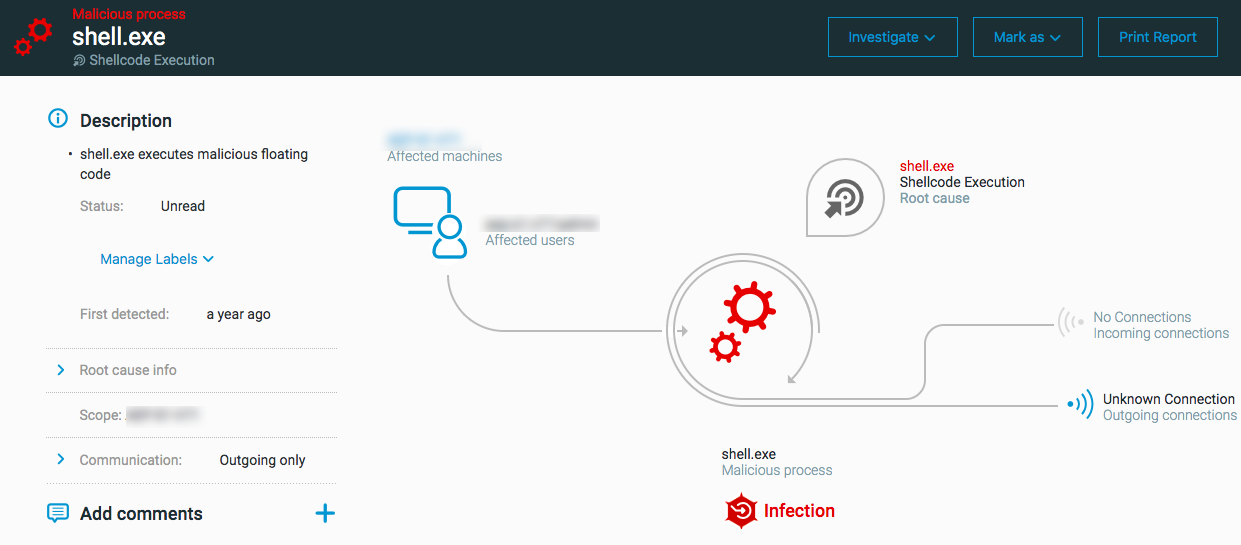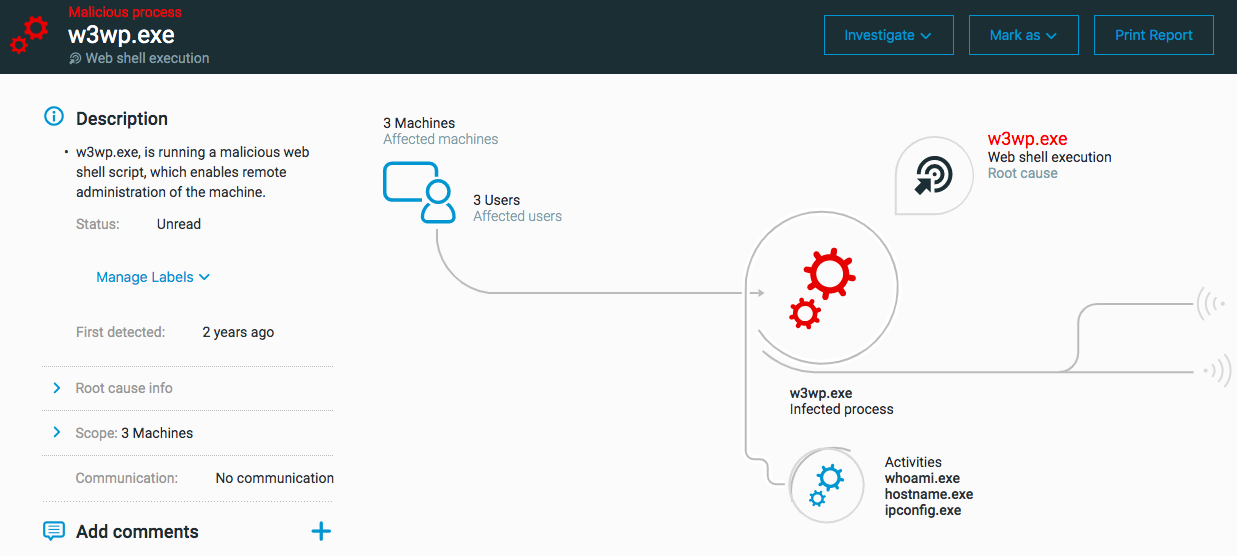Malicious Process MalOps
Malicious process behaviors include actions by processes classified or detected as malicious or processes running in strange ways. The MalOp types listed in this topic are triggered by various malicious process behaviors.
These MalOps are part of the Verified group.
Attempt to stop or disable the Cybereason service
The ‘Attempt to stop or disable the Cybereason service’ MalOp is triggered when a process makes attempts to try to interfere with Cybereason services running on a machine. The Sensor has a number of programs and services to help with the Sensor’s data collection on the machine. Attempts to disable the Cybereason service should be seen as a precursor to malicious activity as the attacker attempts to remove barriers to movement on the machine.
Supported OS for this MalOp: Windows
The following examples describe behavior that can trigger a Attempt to stop or disable the Cybereason service MalOp:
Stopping of the Cybereason service
Suspension of Anti-Malware
Next steps: Attempt to stop or disable the Cybereason service
Investigate the process performing these attempts.
Investigate the process hierarchy.
Remediate the process if necessary.
Restart the Cybereason services if necessary.
Fileless malware
The ‘Fileless Malware’ MalOp is triggered when a process executes a malicious payload that exists in the machine memory. Fileless malware is the execution of malware without the need to install a program or file on a machine. The malware loads its payload into memory without dropping the payload on the file system. Often these attacks are executed with scripting engines, such as PowerShell, the Windows scripting host, and bash. This enables attackers to use the operating system functionality against the machine and evade common security protocols and programs.
Supported OS for this MalOp: Windows
The following examples describe behavior that can trigger a Fileless Malware MalOp:
Use of the Apfell framework on macOS
Running a payload with Python on macOS
Next steps: Fileless malware
Investigate the process in question and the process hierarchy.
Examine the loaded modules and command line for the process.
Investigate whether the process was launched by a scheduled task or WMI activity to look for persistence.
Check to see if the process has network connections and compare their details with known threat intelligence.
Java-based Malware
The ‘Java-based Malware’ MalOp is triggered when a process exhibits behaviors similar to a Java-based Remote Access Trojan. Java-based malware involves packaging the malware program as a Java .jar file, often sent as an email attachment. This enables the attacker to hide their malicious programs in what appears to be a legitimate file that when opened, will silently install and run the malware in their environments.
Supported OS for this MalOp: Windows
Next steps: Java-based Malware
Investigate the process and process hierarchy.
Check if Java is approved in the environment as well as the Java details.
Malicious use of an OS process
The ‘Malicious use of an OS process’ MalOp is triggered when a process uses an OS process in an unusual way. The misuse of operating system features is an attack technique where the attacker tries to hide their activities under the guise of a legitimate operating system function.
Supported OS for this MalOp: Windows
The following examples describe behavior that can trigger a Impersonation of an OS process MalOp:
Use of certutil.exe utility to encode/decode data or download files
Running malicious code with Regsvr32
Opening a reverse shell on macOS
Next steps: Malicious use of OS process
Investigate the process image file.
Investigate the process hierarchy for evidence of strange activity.
Malicious process behavior
The ‘Malicious process behavior’ MalOp is triggered when Behavioral execution protection detects unusual process behavior that may indicate misuse of legitimate software to execute an attack. The misuse of legitimate software functionality is an attack technique where the attacker tries to hide their activities under the guise of a legitimate process.
The Signature field contains the rule ID, which indicates the behavior that triggered the rule.
Supported OS for this MalOp: Windows
The following examples describe behavior that can trigger a ‘Malicious process behavior’ MalOp:
Executing a fileless script with the MSHTA or RunDLL32 utilities
Using reg.exe for credential dump activity
Exploiting the Microsoft Exchange application pool (MSExchangeOWAAppPool)
Malicious exploit attempt
The ‘Malicious exploit attempt’ MalOp is triggered when Cybereason Exploit protection detects and blocks an exploit attempt on a process.
The following examples describe behavior that can trigger a “Malicious exploit attempt” MalOp:
A user opens a malicious Word document or a PDF file that contains an exploit.
An attacker that previously gained code execution on the host machine injects shellcode to one of the processes protected by exploit protection.
Next steps: Malicious exploit attempt
Investigate the exploit attempt and ensure that the exploit attempt was not a false positive.
If the exploit attempt is valid, assess other malicious activities around the vulnerable software and make sure to apply relevant patches.
Malicious floating module
The ‘Malicious floating module’ MalOp is triggered when the Cybereason platform’s NGAV component detects the presence of a floating module used in a malicious manner on a machine.
Next steps: Malicious floating module
Investigate the process that loaded the module
Investigate the specific module identified as malicious
Remove the module from the machine if necessary
Malicious InstallUtil process execution
The ‘Malicious InstallUtil process execution’ MalOp is triggered when a process launches the InstallUtil utility program to make external connections.
Supported OS for this MalOp: Windows
Next steps: Malicious InstallUtil process execution
Investigate the process that launched the InstallUtil utility
Examine the command line used by the process.
Kill the process if necessary.
Malicious execution of MSBuild process by MS Office process
The ‘Malicious execution of MSBuild process by MS Office process’ MalOp is triggered when the MSBuild program is launched by an MS Office program.
Supported OS for this MalOp: Windows
Next steps: Malicious execution of MSBuild process
Examine the process that launched MSBuild and the process hierarchy.
Kill the process that launched MS Build if necessary.
Malicious .NET process compilation
The ‘Malicious .NET process compiler’ MalOp is triggered when a process launches a .NET-based compiler process that then performs malicious activity.
Supported OS for this MalOp: Windows
Next steps: Malicious .NET process compilation
Examine the process that launched the .NET compiler.
Examine the process hierarchy.
Kill the proces that launched the compiler and the compiler process.
Malicious MSBuild process execution with outgoing connections
The ‘Malicious MSBuild process execution with outgoing connections’ MalOp is triggered when the MSBuild process runs with temporary parameters in the command line and the process makes external connections.
Supported OS for this MalOp: Windows
Next steps: Malicious MSBuild process execution with outgoing connection
Examine the MSBuild process.
Examine the command line used for the MSBuild process.
Isolate the machine if needed.
Msmpeng.exe process mismatch
The ‘Msmpeng.exe process mismatch’ MalOp is triggered when the msmpeng.exe operating system process is renamed to another process.
Supported OS for this MalOp: Windows
Next steps: Msmpeng.exe process mismatch
Investigate the renamed process.
Kill the process if necessary.
Process was initiated by a malicious packed binary
The ‘Process was initiated by a malicious packed binary’ MalOp is triggered when a process runs a DLL file that was found to be packed using a special packer process. Packed processes involve packing a process file or binary file as an attempt to hide malicious content.
Supported OS for this MalOp: Linux
Next steps: Packed process
Investigate the process loading the DLL file.
Remediate the malicious DLL file on the machine if necessary.
Process opened a malicious file
The ‘Process opened a malicious file’ MalOp is triggered when a process opens a file that either Cybereason Threat Intelligence or Cybereason behavioral document protection has classified as malicious. Malicious processes commonly use non-executable files, such as documents or scripts, to run malicious code that executes problematic or malicious files.
Supported OS for this MalOp: Windows
The following examples describe behavior that can trigger a “Malicious by opening malicious file” MalOp:
Running malicious files for known hacking tools
Opening a Word, Excel, or PowerPoint file that includes a malicious macro
Next steps: Malicious file
Investigate the files through the Suspicion details.
Examine the process hierarchy.
Investigate the process to see if the process is making any network connections.
If Cybereason determines that the file is malicious, quarantine or remove the file.
Process ran malicious command
The ‘Process ran malicious command’ MalOp is triggered when a PowerShell process was identified trying to run a malicious command or payload that contains either a malicious function or malicious content.
Supported OS for this MalOp: Windows
Next steps: Process ran malicious command
Investigate the payload identified as malicious content.
Review connection activity associated with the PowerShell process and child processes.
Process has loaded Cobalt Strike Beacon
The ‘Process has loaded Cobalt Strike Beacon’ MalOp is triggered when a process loads the Cobalt Strike Beacon tool on a machine. The Cobalt Strike Beacon is a known malicious tool framework for Command and Control operations.
Supported OS for this MalOp: Windows
Next steps: Cobalt Strike Beacon
Isolate the machine as soon as possible.
Investigate the process loading the Cobalt Strike tool, using the platform (not through an investigation query).
Remediate/remove the Cobalt Strike tool.
Examine the process hierarchy to see what other activities the process is attempting to perform.
Contact the Cybereason GSOC and IR services for further recommendations.
Process has loaded PowerShell Empire
The ‘Process has loaded PowerShell Empire’ MalOp is triggered when the PowerShell Empire agent is launched on a machine. The PowerShell Empire is a malicious agent loaded on a machine loaded after penetration on a machine that enables an attacker to run PowerShell commands remotely from the machine. The use of this is part of Command and Control operations.
Supported OS for this MalOp: Windows
Next steps: PowerShell Empire
Investigate the process loading PowerShell Empire.
Examine the process hierarchy to see what other activities the attacker is trying to perform.
Isolate the machine if necessary.
Remediate the PowerShell Empire agent.
Process has loaded a Meterpreter agent
The ‘Process has loaded a Meterpreter Agent’ MalOp is triggered when the Meterpreter agent is started on a machine. The Meterpreter agent is part of the Meterpreter framework. The agent is loaded on a machine start and enables a remote attacker to gain persistence on a machine.
Supported OS for this MalOp: Windows
Next steps: Meterpreter
Investigate the process loading the Meterpreter agent.
Examine the process hierarchy to see what other activities the attacker is trying to perform.
Isolate the machine if necessary.
Remediate the Meterpreter agent.
Process has loaded Mimikatz
The ‘Process has loaded Mimikatz’ MalOp is triggered when a process loads the Mimikatz framework on a machine. The Mimikatz framework is a malicious utility that enables an attacker to view and steal credential information from the Windows LSASS resources.
Supported OS for this MalOp: Windows
Next steps: Mimikatz
Investigate the process loading Mimikatz.
Examine the process hierarchy to see what other activities the attacker is trying to perform.
Isolate the machine if necessary.
Remediate the programs related to Mimikatz.
Process has loaded a PeddleCheap agent
The ‘Process has loaded a PeddleCheap agent’ MalOp is triggered when a Peddle Cheap agent launches on a machine. The PeddleCheap agent is an agent used after penetration on a machine to help with Command and Control with another server.
Supported OS for this MalOp: Windows
Next steps: PeddleCheap
Investigate the process that loaded the PeddleCheap agent.
Examine if the process is making external connections.
Examine the process hierarchy to see what other activities the attacker is trying to perform.
Isolate the machine if necessary.
Remediate the programs related to the PeddleCheap agent.
Process has loaded a malicious tool
The ‘Process has loaded a malicious tool’ MalOp is triggered when the Cybereason platform detects the presence of a malicious tool on a machine. Certain specific tools, such as Mimikatz, Meterpreter, Cobalt Strike, and PeddleCheap trigger unique MalOps for that tool.
Supported OS for this MalOp: Windows
Next steps: Process has loaded a malicious tool
Investigate the process that loaded the malicious agent.
Examine if the process is making external connections.
Examine the process hierarchy to see what other activities the attacker is trying to perform.
Isolate the machine if necessary.
Remediate the programs related to the malicious agent.
Remote Access Trojan
The MalOp for Remote Access Trojan is triggered when a process exhibits behavior like a Remote Access Trojan. Remote Access Trojans are software set to invisibly invade a machine and then allow remote access to the same machine.
Supported OS for this MalOp: Windows, Mac OS, and Linux
Next steps: Remote Access Trojan
Investigate the process.
Examine the process hierarchy.
Investigate the connections the process is making
Isolate the machine as necessary.
Shellcode execution
The MalOp for ‘Shellcode execution’ is triggered when a process is found to be running injected shellcode. Shellcode enables an attacker to open a command window after code is injected into a process. From there, this attacker can perform the commands he or she needs as needed.
Supported OS for this MalOp: Windows
Next steps: Shellcode injection
Investigate the process and process hierarchy.
Investigate the process’s connections.
Sliver Shell tool execution
The MalOp for ‘Sliver Shell tool execution’ is triggered when a process runs the Sliver shell tool program on a machine.
Supported OS for this MalOp: Windows
Next steps: Sliver Shell tool execution
Investigate the process and process hierarchy.
Kill the process in question.
Isolate the machine if necessary
Web shell execution
The ‘Web shell execution’ MalOp is triggered when the Cybereason platform sees a strange pattern of behavior for a web server process. Web shells are scripts used on an accessible Web server which enables the attacker to have a gateway into a network.
Supported OS for this MalOp: Windows, MacOS, and Linux
Next steps: Web shell execution
Examine the process hierarchy.
Examine the process command line, with special attention to find processes running file system or system commands.
Investigate the process connections to find connections open for multiple minutes.
